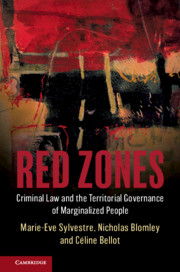Book contents
- Red Zones
- Red Zones
- Copyright page
- Dedication
- Contents
- Figures
- Maps
- Tables
- Acknowledgments
- Cases
- Legislation
- 1 Navigating the Territories of the Law
- Part I Foundations
- Part II Expansion
- Part III Territorialization and Its Consequences
- 6 Territorializing: How Legal Territory Is Made and Justified
- 7 Conditional Life inside the Red Zone
- 8 Red Zoning Politics
- Conclusion
- Bibliography
- Index
8 - Red Zoning Politics
from Part III - Territorialization and Its Consequences
Published online by Cambridge University Press: 06 February 2020
- Red Zones
- Red Zones
- Copyright page
- Dedication
- Contents
- Figures
- Maps
- Tables
- Acknowledgments
- Cases
- Legislation
- 1 Navigating the Territories of the Law
- Part I Foundations
- Part II Expansion
- Part III Territorialization and Its Consequences
- 6 Territorializing: How Legal Territory Is Made and Justified
- 7 Conditional Life inside the Red Zone
- 8 Red Zoning Politics
- Conclusion
- Bibliography
- Index
Summary
Chapter 8 focuses on the impact of red zones and other bail and sentencing conditions of release on demonstrators’ lives and uses of public spaces. It documents protesters’ violent encounters with the criminal justice system and their experiences of banishment and carcerality. It also emphasizes how such orders curtail activism and political organizing. Recognizing the strategic connection between dissent and public spaces, this chapter suggests that legal actors play a crucial role in regulating who can access designated spaces at specific (strategic) times, and, more importantly, which political voices and messages are heard.
Keywords
- Type
- Chapter
- Information
- Red ZonesCriminal Law and the Territorial Governance of Marginalized People, pp. 190 - 208Publisher: Cambridge University PressPrint publication year: 2020

